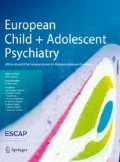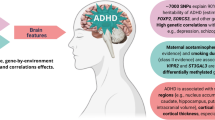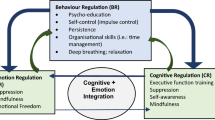Abstract
Parents of children with attention deficit hyperactivity disorder (ADHD) have been found to prefer sensory integration (SI) training rather than guideline-recommended ADHD treatment. This study investigated whether SI intervention for children with ADHD was associated with a reduced risk of subsequent mental disorders. From children < 8-years-old newly diagnosed with ADHD in a nationwide population-based dataset, we established a SI cohort and a non-SI cohort (N = 1945) matched by propensity score. Incidence and hazard ratios of subsequent psychiatric disorders were compared after a maximum follow-up of 9 years. The incidence of psychiatric disorders was 1.4-fold greater in the SI cohort, with an adjusted hazard ratio of 1.41 (95% confidence interval 1.20–1.67), comparing to the non-SI cohort. Risks were elevated for emotional disturbances, conduct disorders, and adjustment disorders independent of age, gender, or comorbidity. Among children with only psychosocial intervention, the incidence of psychiatric disorders was 3.5-fold greater in the SI cohort than in the non-SI cohort. To our knowledge, this is the first study to report an increased risk of developing psychiatric disorders for children with ADHD who received SI compared to those who did not. Potential adverse effects of SI for ADHD children should be carefully examined and discussed before practice.

Similar content being viewed by others
References
Gau SS, Chong MY, Chen TH, Cheng AT (2005) A 3-year panel study of mental disorders among adolescents in Taiwan. Am J Psychiatry 162:1344–1350
Skounti M, Philalithis A, Mpitzaraki K, Vamvoukas M, Galanakis E (2006) Attention-deficit/hyperactivity disorder in schoolchildren in Crete. Acta Paediatr 95:658–663
Cornejo JW, Osio O, Sanchez Y, Carrizosa J, Sanchez G, Grisales H et al (2005) Prevalence of attention deficit hyperactivity disorder in Colombian children and teenagers. Rev Neurol 40:716–722
Polanczyk G, Rohde LA (2007) Epidemiology of attention-deficit/hyperactivity disorder across the lifespan. Curr Opin Psychiatry 20:386–392
Matza LS, Paramore C, Prasad M (2005) A review of the economic burden of ADHD. Cost Effectiveness Resour Allocation C/E 3:5
Barkley RA, Fischer M, Smallish L, Fletcher K (2004) Young adult follow-up of hyperactive children: antisocial activities and drug use. J Child Psychol Psychiatry 45:195–211
Young S, Thome J (2011) ADHD and offenders. World J Biol Psychiatry 12(Suppl 1):124–128
Herman KC, Lambert SF, Ialongo NS, Ostrander R (2007) Academic pathways between attention problems and depressive symptoms among urban African American children. J Abnorm Child Psychol 35:265–274
Ostrander R, Crystal DS, August G (2006) Attention deficit-hyperactivity disorder, depression, and self- and other-assessments of social competence: a developmental study. J Abnorm Child Psychol 34:773–787
Ostrander R, Herman KC (2006) Potential cognitive, parenting, and developmental mediators of the relationship between ADHD and depression. J Consult Clin Psychol 74:89
Donfrancesco R, Miano S, Martines F, Ferrante L, Melegari MG, Masi G (2011) Bipolar disorder co-morbidity in children with attention deficit hyperactivity disorder. Psychiatry Res 186:333–337
Jerrell JM, McIntyre RS, Park YM (2014) Correlates of incident bipolar disorder in children and adolescents diagnosed with attention-deficit/hyperactivity disorder. J Clin Psychiatry 75:e1278–e1283
Singh MK, DelBello MP, Kowatch RA, Strakowski SM (2006) Co-occurrence of bipolar and attention-deficit hyperactivity disorders in children. Bipolar Disord 8:710–720
Tillman R, Geller B (2006) Controlled study of switching from attention-deficit/hyperactivity disorder to a prepubertal and early adolescent bipolar I disorder phenotype during 6-year prospective follow-up: rate, risk, and predictors. Dev Psychopathol 18:1037–1053
Williford AP, Shelton TL (2014) Behavior management for preschool-aged children. Child Adolesc Psychiatr Clin N Am 23:717–730
Pliszka S (2007) Practice parameter for the assessment and treatment of children and adolescents with attention-deficit/hyperactivity disorder. J Am Acad Child Adolesc Psychiatry 46:894–921
Charach A, Dashti B, Carson P et al (2011) Attention deficit hyperactivity disorder: effectiveness of treatment in at-risk young childrens; long-term effectiveness in all ages; and variability in prevalence, diagnosis, and treatment
Domitrovich CE, Cortes RC, Greenberg MT (2007) Improving young children’s social and emotional competence: a randomized trial of the preschool “PATHS” curriculum. J Prim Prev 28(2):67–91
Domitrovich CE, Gest SD, Jones D, Gill S, Sanford Derousie RM (2010) Implementation quality: lessons learned in the context of the head start REDI trial. Early Child Res Q 25(3):284–298
Herrerias CT, Perrin JM, Stein MT (2001) The child with ADHD: using the AAP Clinical Practice Guideline. American Academy of Pediatrics. Am Fam Physician 63:1803–1810
Wolraich M, Brown L, Brown RT, DuPaul G, Earls M, Feldman HM et al (2011) ADHD: clinical practice guideline for the diagnosis, evaluation, and treatment of attention-deficit/hyperactivity disorder in children and adolescents. Pediatrics 128:1007–1022
Tzang R-F, Chang Y-C, Hung S-T, Tang C-H (2015) Under-diagnosis of attention deficit hyperactivity disorder in one of non-western country-taiwan. Int J Emerg Ment Health Hum Resil 17:206–209
Dreyer BP (2006) The diagnosis and management of attention-deficit/hyperactivity disorder in preschool children: the state of our knowledge and practice. Curr Prob Pediatr Adolesc Health Care 36:6–30
Smith SA, Press B, Koenig KP, Kinnealey M (2005) Effects of sensory integration intervention on self-stimulating and self-injurious behaviors. Am J Occup Ther 59:418–425
May-Benson TA, Koomar JA (2010) Systematic review of the research evidence examining the effectiveness of interventions using a sensory integrative approach for children. Am J Occup Ther Off Publ Am Occup Ther Assoc 64:403–414
Zimmer M, Desch L (2012) Sensory integration therapies for children with developmental and behavioral disorders. Pediatrics 129:1186–1189
Hender K. Effectiveness of sensory integration therapy for attention deficit hyperactivity disorder (ADHD). Evidence Centre Critical Appraisal. Series 2001. http://www.med.monash.edu.au/healthservices/cce/evidence/
Vargas S, Camilli G (1999) A meta-analysis of research on sensory integration treatment. Am J Occup Ther 53:189–198
Polatajko HJ, Cantin N (2010) Exploring the effectiveness of occupational therapy interventions, other than the sensory integration approach, with children and adolescents experiencing difficulty processing and integrating sensory information. Am J Occup Ther 64:415–429
Ghanizadeh A (2011) Sensory processing problems in children with ADHD, a systematic review. Psychiatry Investig 8:89–94
NHIRD. Introduction to the National Health Insurance Research Database (NHIRD), Taiwan Taiwan: National Health Insurance Research Database; 2006. http://www.nhri.org.tw/nhird/en/index.htm
Wu SI, Kao KL, Chen SC, Juang J, Lin CJ, Fang CK et al (2015) Antipsychotic exposure prior to acute myocardial infarction in patients with serious mental illness. Acta Psychiatr Scand 131:213–222
WHO. World Health Organization, Collaborating Centre for Drug Statistic Methodology: Guidelines for ATC Classification and DDD Assignment. Oslo, Norway 2009
Villemonteix T, Purper-Ouakil D, Romo L (2015) Is emotional dysregulation a component of attention-deficit/hyperactivity disorder (ADHD)? L’Encephale 41:108–114
Burke JD, Loeber R, Lahey BB, Rathouz PJ (2005) Developmental transitions among affective and behavioral disorders in adolescent boys. J Child Psychol Psychiatry 46:1200–1210
Pliszka SR (2000) Patterns of psychiatric comorbidity with attention-deficit/hyperactivity disorder. Child Adolesc Psychiatr Clin N Am 9:525–540, vii
DosReis S, Barksdale CL, Sherman A, Maloney K, Charach A (2010) Stigmatizing experiences of parents of children with a new diagnosis of ADHD. Psychiatr Serv (Washington, DC) 61:811–816
Chan MF, Mok E, Wong YS, Tong TF, Day MC, Tang CK et al (2003) Attitudes of Hong Kong Chinese to traditional Chinese medicine and Western medicine: survey and cluster analysis. Complement Ther Med. 11:103–109
Huang A, Seshadri K, Matthews TA, Ostfeld BM (2013) Parental perspectives on use, benefits, and physician knowledge of complementary and alternative medicine in children with autistic disorder and attention-deficit/hyperactivity disorder. J Altern Complement Med (New York, NY) 19:746–750
Long L, Huntley A, Ernst E (2001) Which complementary and alternative therapies benefit which conditions? A survey of the opinions of 223 professional organizations. Complement Ther Med 9:178–185
Charach A, Dashti B, Carson P, Booker L, Lim CG, Lillie E et al (2011) AHRQ comparative effectiveness reviews. In: Attention deficit hyperactivity disorder: effectiveness of treatment in at-risk young childrens; long-term effectiveness in all ages; and variability in prevalence, diagnosis, and treatment. Agency for healthcare research and quality (US)
Tzang RF, Wang YC, Yeh CB, Hsu CD, Liang HY, Yang PC et al (2012) Naturalistic exploration of the effect of osmotic release oral system-methylphenidate on remission rate and functional improvement in Taiwanese children with attention-deficit–hyperactivity disorder. Psychiatry Clin Neurosci 66:53–63
Wolff C, Alfred A, Lindermüller A, Rettig K, Mattejat F, Gerwe M et al (2011) Effect of transitioning from extended-release methylphenidate onto osmotic, controlled-release methylphenidate in children/adolescents with ADHD: results of a 3-month non-interventional study. Curr Med Res Opin 27:35–44
Acknowledgments
This research team is supported in part by the Bureau of Health Promotion, Department of Health, Taiwan (DOH99-HP-1205); Taiwan Ministry of Health and Welfare Clinical Trial and Research Center of Excellence (MOHW107-TDU-B-212-123004), the research laboratory of pediatrics, Children’s Hospital of China Medical University (grant number DMR-105-042), China Medical University Hospital (DMR-106-025), Academia Sinica Taiwan Biobank Stroke Biosignature Project (BM10701010021), NRPB Stroke Clinical Trial Consortium (MOST 106-2321-B-039-005), Tseng-Lien Lin Foundation, Taichung, Taiwan, Taiwan Brain Disease Foundation, Taipei, Taiwan, Katsuzo and Kiyo Aoshima Memorial Funds, Japan, Department of Medical Research, Mackay Memorial Hospital (MMH-106-93, MMH-106-55, MMH-106-44). RS is part-funded by the National Institute for Health Research (NIHR) Biomedical Research Centre and Dementia Biomedical Research Unit at South London and Maudsley NHS Foundation Trust and King’s College London.
Author information
Authors and Affiliations
Contributions
Authors RFT, YCC, KLK, YCW, and SIW designed the study and wrote the protocol. Authors YCW, CHM, and SIW undertook the statistical analysis, and author RFT wrote the first draft of the manuscript. All authors contributed to the writing and have approved the final manuscript.
Corresponding authors
Ethics declarations
Conflict of interest
RS has received research funding in the last 5 years from Roche, Janssen and GSK. All other authors declare that they have no conflicts of interest.
Rights and permissions
About this article
Cite this article
Tzang, RF., Chang, YC., Kao, KL. et al. Increased risk of developing psychiatric disorders in children with attention deficit and hyperactivity disorder (ADHD) receiving sensory integration therapy: a population-based cohort study. Eur Child Adolesc Psychiatry 28, 247–255 (2019). https://doi.org/10.1007/s00787-018-1171-7
Received:
Accepted:
Published:
Issue Date:
DOI: https://doi.org/10.1007/s00787-018-1171-7




